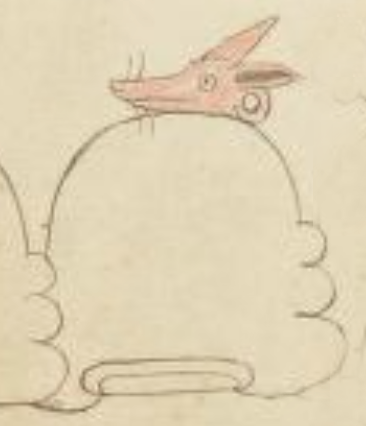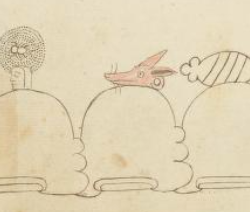Coyohuacan (Azca23)
This painted black-line drawing of the compound place name Coyohuacan (“Place Where People Have Coyotes”) shows the head of a coyote (coyotl) facing left. This head is painted a pinkish red. Its ears are back, its visible eye is open, and it has long whiskers. Below the left ear is a hole (coyoctli), which is a phonetic complement to the coyotl, ensuring the reading that this is a coyote and not a dog or the like. The hill or mountain (tepetl) upon which the coyotl head rests may serve here as the visual for the locative suffix (-can, where). The hill in this case overlaps with another one on the left, so the viewer cannot see the rocky outcroppings that should appear on this hill on the left side. The rocky iconography is semantic, but it also serves to provide the phonetic -te start to tepetl (from tetl).
Stephanie Wood
Since this glyph is not glossed, we are unsure whether it refers to Coyohuacan or Coyotepec. The presence of the tepetl may well have a part in the place name. Find examples of a compound glyph for Coyohuacan and one for Coyotepec, below. In the Coyohuacan example, the whole animal appears, but his body does also have a hole through it.
Stephanie Wood
post-1550, possibly from the early seventeenth century.
Jeff Haskett-Wood
coyotes, animales, hoyos, nombres de lugares

coyo(tl), coyote, https://nahuatl.wired-humanities.org/content/coyotl
coyoc(tli), hole, https://nahuatl.wired-humanities.org/content/coyoctli
-hua- or -huah (possessor suffix), https://nahuatl.wired-humanities.org/content/hua
Coyohuacan, an important altepetl south of Mexico City, https://nahuatl.wired-humanities.org/content/coyohuacan
-can (locative suffix), https://nahuatl.wired-humanities.org/content/can-2
Coyote
Stephanie Wood
The Codex Azcatitlan is also known as the Histoire mexicaine, [Manuscrit] Mexicain 59–64. It is housed in the Bibliothèque Nationale de France, and hosted on line by the World Digital Library and the Library of Congress, which is “unaware of any copyright or other restrictions in the World Digital Library Collection.”
https://www.loc.gov/resource/gdcwdl.wdl_15280/?sp=23&st=image
The Library of Congress is “unaware of any copyright or other restrictions in the World Digital Library Collection.” But please cite Bibliothèque Nationale de France and this Visual Lexicon of Aztec Hieroglyphs.



